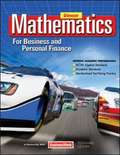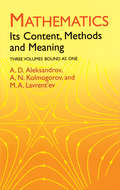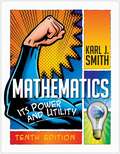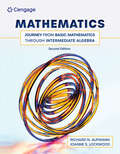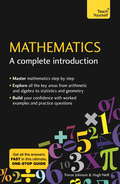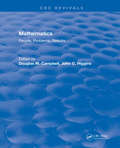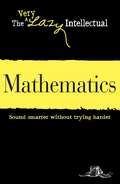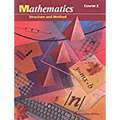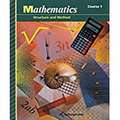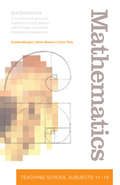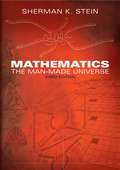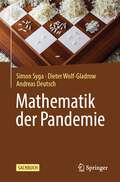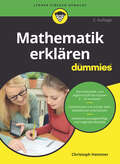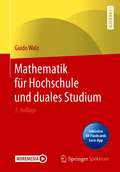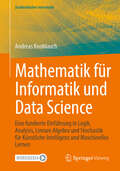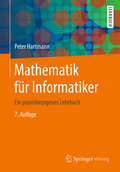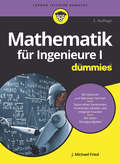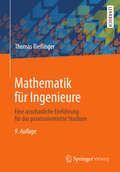- Table View
- List View
Mathematics: Applications and Concepts, Course 2 [Grade 7] Ohio
by Roger Day Patricia Frey Rhonda BaileyMathematics: Applications and Concepts is a three-text Middle School series intended to bridge the gap from Elementary Mathematics to High School Mathematics. The program is designed to motivate middle school students, enable them to see the usefulness of mathematics in the world around them, enhance their fluency in the language of mathematics, and prepare them for success in Algebra and Geometry.
Mathematics: Bullet Guides
by Sophie GoldieOpen this book and you will Be numerate Understand key principles Conquer difficult problems Handle data confidently
Mathematics: Bullet Guides
by Sophie GoldieOpen this book and you will Be numerate Understand key principles Conquer difficult problems Handle data confidently
Mathematics: For Business and Personal Finance
by Temoleon G. Rousos Walter H. LangeNew Mathematics for Business and Personal Finance is the only text on the market that offers teachers point-of-use online professional development, interactive online help for students and the option of purchasing an interactive online text with a grade book. As always, we have maintained our exclusive coverage of key core academic content, and our research-based reading strategies. When it comes to helping students and making life easier for teachers, Glencoe is number one!.
Mathematics: Its Content, Methods and Meaning (Dover Books on Mathematics)
by A. N. Kolmogorov A. D. Aleksandrov M. A. Lavrent’evThis major survey of mathematics, featuring the work of 18 outstanding Russian mathematicians and including material on both elementary and advanced levels, encompasses 20 prime subject areas in mathematics in terms of their simple origins and their subsequent sophisticated developement. As Professor Morris Kline of New York University noted, "This unique work presents the amazing panorama of mathematics proper. It is the best answer in print to what mathematics contains both on the elementary and advanced levels."Beginning with an overview and analysis of mathematics, the first of three major divisions of the book progresses to an exploration of analytic geometry, algebra, and ordinary differential equations. The second part introduces partial differential equations, along with theories of curves and surfaces, the calculus of variations, and functions of a complex variable. It furthur examines prime numbers, the theory of probability, approximations, and the role of computers in mathematics. The theory of functions of a real variable opens the final section, followed by discussions of linear algebra and nonEuclidian geometry, topology, functional analysis, and groups and other algebraic systems.Thorough, coherent explanations of each topic are further augumented by numerous illustrative figures, and every chapter concludes with a suggested reading list. Formerly issued as a three-volume set, this mathematical masterpiece is now available in a convenient and modestly priced one-volume edition, perfect for study or reference.
Mathematics: Its Power and Utility Tenth Edition
by Karl J. SmithIN THIS BOOK, we look at the power of mathematics, not the drudgery of number crunching. We look back through history and see how the power of mathematics has revolutionized the world. We also take an in-depth look at the utility of mathematics--how it is useful to you now--rather than telling you that it might be useful someday. The main theme throughout the book is problem solving.
Mathematics: Journey from Basic Mathematics through Intermediate Algebra
by Richard N. Aufmann Joanne S. LockwoodAufmann/Lockwood's MATHEMATICS: JOURNEY FROM BASIC MATHEMATICS THROUGH INTERMEDIATE ALGEBRA, 2nd Edition, and WebAssign, delivers learning objectives organized by section in 22 modules spanning the entire developmental mathematics sequence -- basic mathematics, prealgebra, introductory algebra, intermediate algebra and an introduction to trigonometry -- in one, ready-to-go, flexible resource. Enrich the teaching and learning experience with the superior content within the powerful digital platform of WebAssign that helps your students master the course concepts. No matter your syllabus needs or course environment, you have everything needed to get started with minimal setup time. Tailor your course with a wide range of assignment settings, the ability to add questions and content, analytics at the individual and course level and student/teacher communication tools. The learning resources for students include the eTextbook, multiple opportunities to practice skills and concepts with the Guided Workbook and AIM for Success Practice Sheets, videos with practice questions and the online learning platform, WebAssign -- all designed to accommodate the student’s unique learning path.
Mathematics: Maths Revision Made Easy
by Hugh Neill Trevor JohnsonMaths does not have to be difficult. This book, complete with exercises and answers, forms a course which will take you from beginner or intermediate level to being a confident mathematician. This book includes: simple step-by-step explanations, to help you grasp new topics or those that have previously confused you; practice questions throughout, to help you embed your learning and improve your confidence; and end of chapter summaries, to help you remember the key points you've learned - all in one great-value book, so you don't need any separate workbooks or coursebooks.Chapters include: number; angles; fractions; two-dimensional shapes; decimals; statisticsl directed numbers; graphs; measurement; perimeter and area; algebraic expressions; approximations; equations; percentages; formulae; circles; probability; three-dimensional shapes; ratio and proportion; pythagoras' theorem and trigonometry; indices and standard form.ABOUT THE SERIESThe Complete Introduction series from Teach Yourself is the ultimate one-stop guide for anyone wanting a comprehensive and accessible entry point into subjects as diverse as philosophy, mathematics, psychology, Shakespeare and practical electronics. Loved by students and perfect for general readers who simply want to learn more about the world around them, these books are your first choice for discovering something new.
Mathematics: People, Problems, Results
by Douglas M. CampbellTo understand why mathematics exists and why it is perpetuated one must know something of its history and of the lives and results of famous mathematicians. This three-volume collection of entertaining articles will captivate those with a special interest in mathematics as well as arouse those with even the slightest curiosity about the most sophisticated sciences.
Mathematics: Sound smarter without trying harder (The Very Lazy Intellectual)
by Adams MediaDo have trouble figuring out a restaurant tip? Does the thought of algebra still give you nightmares? Fear not! The Very Lazy Intellectual: Mathematics introduces you to quantitative calculation and logical reasoning. Unlock the mysteries (or at least the basics) of algebra, calculus, geometry, and trigonometry!
Mathematics: Structure and Method (Course 1 #2)
by Mary P. Dolciani Robert H. Sorgenfrey John A. GrahamThis book covers a variety of topics under mathematics ranging from Probability, Rational Numbers, Equations, and Algebra, along with useful problem solving techniques.
Mathematics: Structure and Method, Course 1
by Mary P. Dolciani Robert H. Sorgenfrey John A. GrahamMathematics: Structure and Method, Course 1 is a resource book for students of Mathematics.
Mathematics: Teaching School Subjects 11-19 (Teaching School Subjects 11-19)
by Anne Watson Candia Morgan Clare TiklyThis accessible and thought-provoking book considers what beginning teachers need to know about learning, teaching, assessment, curriculum and professional development, in the context of teaching mathematics to eleven to nineteen year olds. It is part of a new series of books that has as its starting point the fact that PGCE students are already subject specialists.The authors show how mathematics teachers can communicate their own enthusiasm for the subject and inspire their pupils to learn and enjoy learning. They provide practical advice which will help teachers and student teachers to: plan, organize, manage and assess classroom work make decisions about the content, ordering and level of difficulty of lessons make sense of new subject material and how it contributes to wider educational aims develop professionally by developing the subject as a whole. This is a comprehensive introduction to teaching mathematics in the secondary school which will be invaluable to teachers beginning their careers and those who are training to be mathematics teachers.
Mathematics: The Easy Way to Learn Maths
by Hugh Neill Trevor JohnsonMaths does not have to be difficult. This book, complete with exercises and answers, forms a course which will take you from beginner or intermediate level to being a confident mathematician. This book includes: simple step-by-step explanations, to help you grasp new topics or those that have previously confused you; practice questions throughout, to help you embed your learning and improve your confidence; and end of chapter summaries, to help you remember the key points you've learned - all in one great-value book, so you don't need any separate workbooks or coursebooks.Chapters include: number; angles; fractions; two-dimensional shapes; decimals; statisticsl directed numbers; graphs; measurement; perimeter and area; algebraic expressions; approximations; equations; percentages; formulae; circles; probability; three-dimensional shapes; ratio and proportion; pythagoras' theorem and trigonometry; indices and standard form.ABOUT THE SERIESThe Complete Introduction series from Teach Yourself is the ultimate one-stop guide for anyone wanting a comprehensive and accessible entry point into subjects as diverse as philosophy, mathematics, psychology, Shakespeare and practical electronics. Loved by students and perfect for general readers who simply want to learn more about the world around them, these books are your first choice for discovering something new.
Mathematics: The Man-made Universe (Dover Books on Mathematics)
by Sherman K. SteinAnyone can appreciate the beauty, depth, and vitality of mathematics with the help of this highly readable text, specially developed from a college course designed to appeal to students in a variety of fields. Readers with little mathematical background are exposed to a broad range of subjects chosen from number theory, topology, set theory, geometry, algebra, and analysis. Starting with a survey of questions on weight, the text discusses the primes, the fundamental theorem of arithmetic, rationals and irrationals, tiling, tiling and electricity, probability, infinite sets, and many other topics. Each subject illustrates a significant idea and lends itself easily to experiments and problems. Useful appendices offer an overview of the basic ideas of arithmetic, the rudiments of algebra, suggestions on teaching mathematics, and much more, including answers and comments for selected exercises.
Mathematik der Pandemie
by Andreas Deutsch Dieter Wolf-Gladrow Simon SygaDie COVID-19-Pandemie hat weltweit dramatische Folgen. Mathematische Modelle spielen bei ihrer Bewertung eine zentrale Rolle: Sie sollen die Wirkung von Maßnahmen abschätzen, die oft mit Einschränkungen individueller Freiheiten einhergehen. Umso mehr sollte das Wissen um die Mathematik der Pandemie nicht nur Experten überlassen bleiben. Dieses Buch erläutert grundlegende Begriffe und Modelle, und klärt weitverbreitete Missverständnisse auf. Das Buch gibt insbesondere Antwort auf folgende Fragen:Was sagen Kennzahlen wie Inzidenz, Reproduktionszahl, Hospitalisierungsrate oder Impfquote über die Pandemie?Was ist der Unterschied von linearem und exponentiellem Wachstum?Was ist Herdenimmunität? Warum werden sich trotz Herdenimmunität fast alle Ungeimpften anstecken?Was ist der Effekt von Kontaktbeschränkungen und Impfung?Warum sind Vorhersagen in der Pandemie schwierig?
Mathematik erklären für Dummies (Für Dummies)
by Christoph HammerWenn sich ein Kind im Matheunterricht schwertut, sind gute Erklärungen gefragt. Sei es von Eltern, Großeltern, Freunden oder Nachhilfelehrern. Diese Neuauflage von "Mathe für Eltern für Dummies" bereitet wesentliche Themen aus den Klassen 5-10 verständlich auf: vom Bruchrechnen über Variablen, Gleichungen und Funktionen bis hin zu Sachaufgaben. Zahlreiche Beispiele und Abbildungen vermitteln Vorstellungen von dem, was abstrakte Formeln ausdrücken wollen. Ein spezielles Symbol erscheint immer dann im Buch, wenn es um typische Stolpersteine geht. Entwickeln Sie gemeinsam Freude an der Mathematik, denn Begeisterung steckt an!
Mathematik für Biologen
by Dirk HorstmannDieses vierfarbige Kurzlehrbuch konzentriert sich auf die Mathematik-Curricula der Bachelorstudiengänge Biologie. Neben der Vermittlung des mathematischen Grundwissens stellt es den Bezug zu den zugrunde liegenden biologischen Fragestellungen her. Konkrete Beispiele bzw. wissenswerte Zusatzinformationen zu historischen Personen/Wissenschaftlern werden gegeben.Die Themen des Buches sind „chronologisch" aufeinander aufgebaut. Das einleitende Kapitel beschäftigt sich mit möglichen grafischen Darstellungsmöglichkeiten experimentell erhobener Daten. Hier werden bereits erste „stochastische / statistische" Begriffe eingeführt, die in den weiteren Kapiteln im Zusammenhang mit dem Thema Wahrscheinlichkeitsverteilungen und Zufallsvariablen erneut auftauchen.Die zweite Auflage wurde um zusätzliche Anmerkungen zur Fehlerrechnung ergänzt und durch ein Kapitel zu Differenzengleichungen sowie eine Formelsammlung der wichtigsten Formeln und Rechenvorschriften der in dem Buch behandelten Themen erweitert. Neben seiner Einsatzmöglichkeit als Lehr- und Lernmaterial für Studierende und Dozenten kann das Buch auch als ein Nachschlagwerk verwendet werden, das die behandelte Mathematik mit Namen und Sachthemen aus dem Studium oder dem alltäglichen Leben in Verbindung bringt. Hierdurch soll die bei vielen Studierenden existierende „Denkblockade" beiseite geräumt und klar gemacht werden, dass Mathematik in den Lebenswissenschaften eindeutig mehr ist, als die bloße Anwendung von statistischen Methoden.
Mathematik für Hochschule und duales Studium
by Guido WalzDieses Buch führt Sie auf leicht verständliche Weise von den gängigen Bereichen der Linearen Algebra und Analysis bis hin zur Stochastik und Numerik. Es ist in einem unverkrampften und ermutigenden, bisweilen sogar unterhaltsamen Stil geschrieben, der das Lesen leicht macht – ohne es jedoch an der nötigen Exaktheit und Präzision fehlen zu lassen. Viele ausführliche Erklärungen und Beispiele sowie zahlreiche Übungsaufgaben mit Lösungen unterstützen beim Lernen und helfen beim Verstehen des Stoffes – so dass Sie in jede Prüfung mit dem sicheren Gefühl gehen können: „Das kann ich!“Im Rahmen der 3. Auflage wurde das Buch ergänzt durch den kostenlosen Zugang zur Springer Nature Flashcards-App. Hier wird dem Leser exklusives Zusatzmaterial in Form von über 300 neuen Prüfungsfragen zur Verfügung gestellt, mit deren Hilfe man jederzeit den eigenen Leistungsstand ermitteln und Prüfungssimulationen durchführen kann.
Mathematik für Informatik und Data Science: Eine fundierte Einführung in Logik, Analysis, Lineare Algebra und Stochastik für Künstliche Intelligenz und Maschinelles Lernen (Studienbücher Informatik)
by Andreas KnoblauchDieses Buch liefert eine kompakte aber fundierte Darstellung der wichtigsten Gebiete der Mathematik für Informatik, die insbesondere für Data Science, Künstliche Intelligenz und Maschinelles Lernen notwendig sind. Inhaltlich gehören dazu Grundlagen zu Logik und Beweisen, ein- und mehrdimensionale Analysis mit Differential- und Integralrechnung, Lineare Algebra mit Vektor- und Matrixrechnung, linearen Gleichungssystemen, Koordinatentransformationen, Eigenvektoren sowie Wahrscheinlichkeitsrechnung mit Grundlagen der Kombinatorik, Statistik und Informationstheorie. Trotz der kompakten Darstellung werden alle Konzepte und Sätze sorgfältig eingeführt und bewiesen. Nichts soll vom Himmel fallen, sondern aus Axiomen und elementaren Prinzipien hergeleitet werden. Ziel ist es beim Studierenden das befriedigende Gefühl zu erzeugen, alles von Grund auf verstanden zu haben, und nichts nur „glauben“ zu müssen.
Mathematik für Informatiker: Ein praxisbezogenes Lehrbuch
by Peter HartmannDieses Buch enthält den Mathematikstoff, der für das Informatikstudium in anwendungsorientierten Bachelorstudiengängen benötigt wird. Der Inhalt entspringt der langjährigen Lehrerfahrung des Autors.Das heißt:Sie finden immer wieder Anwendungen aus der Informatik.Sie lernen nicht nur mathematische Methoden, es werden auch die Denkweisen der Mathematik vermittelt, die eine Grundlage zum Verständnis der Informatik bilden.Beweise werden dann geführt, wenn Sie daraus etwas lernen können, nicht um des Beweisens willen.Mathematik ist für viele Studierende zunächst ein notwendiges Übel. Das Buch zeigt durch ausführliche Motivation, durch viele Beispiele, durch das ständige Aufzeigen von Querbezügen zwischen Mathematik und Informatik, dass Mathematik nicht nur nützlich ist, sondern interessant sein kann und manchmal auch Spaß macht.
Mathematik für Ingenieure
by Thomas Rießinger"Mathematik in entspannter Atmosphäre" ist das Leitbild dieses leicht verständlichen Lehrbuchs. Im Erzählstil und mit vielen Beispielen beleuchtet der Autor nicht nur die Höhere Mathematik, sondern er stellt auch den Lehrstoff in Bezug zu den Anwendungen. Die gesamte für den Ingenieurstudenten wichtige Mathematik wird in einem Band behandelt. Dies gelingt durch Verzicht auf abstrakte Höhen und durch eine prüfungsgerechte Stoffauswahl, die sich streng an den Bedürfnissen des späteren Ingenieurs ausrichtet. Das Buch kann vorlesungsbegleitend oder zum Selbststudium eingesetzt werden. Die 159 Übungsaufgaben mit Lösungen unterstützen das Einüben des Lehrstoffs und sind im Band "Übungsaufgaben zur Mathematik für Ingenieure" ausführlich durchgerechnet.Der "Brückenkurs" beim Buch auf springer.com erleichtert Anfängern den Einstieg.
Mathematik für Ingenieure I für Dummies (Für Dummies)
by J. Michael FriedAlle Ingenieure benötigen sie - kaum einer mag sie eigentlich: die Mathematik. Aber Ingenieursmathematik muss nicht schwer verständlich sein, sie kann auch Spaß machen. J. Michael Fried vermittelt Ihnen in diesem Buch die Grundlagen der Mathematik, die alle Ingenieure in den ersten Semestern benötigen. Los geht's mit der Linearen Algebra: Lernen Sie, wie Sie mit Vektoren und Matrizen rechnen, lineare Gleichungssysteme lösen und Eigenwerte sowie Eigenvektoren berechnen. Außerdem führt der Autor Sie in die Geheimnisse der eindimensionalen Analysis ein und erklärt alles Wissenswerte zu Folgen und Grenzwerten, zur Differenzial- und zur Integralrechnung. Anhand von vielen Tipps und Praxisbeispielen lernen Sie, wo die erworbenen Kenntnisse in den Ingenieurwissenschaften angewendet werden. Mit Übungsaufgaben und ausführlichen Lösungen können Sie Ihr Wissen auch gleich noch überprüfen und festigen. Dieses Buch richtet sich an Studierende aller Ingenieurwissenschaften - sowohl zum Lernen als auch zum Nachschlagen.
Mathematik für Ingenieure und Naturwissenschaftler
by Wilhelm Merz Peter KnabnerBasierend auf jahrzehntelanger Lehrerfahrung an der Universität Erlangen, bietet das Buch alle Mathematik-Themen, die für Ingenieure in den ersten beiden Semestern an deutschen Universitäten relevant sind: Lineare Algebra und Analysis in einer Raumdimension. Alle Aspekte sind detailliert und anhand kreativer und teils ausgefallener Beispiele dargestellt. Da die meisten Aussagen mit einer Beweisidee versehen sind, ist der Band auch für Lehramtsstudierende (Bachelor) geeignet. Begleitendes Übungsmaterial ist als Video im Internet verfügbar.
Mathematik für Ingenieure: Eine anschauliche Einführung für das praxisorientierte Studium
by Thomas Rießinger"Mathematik in entspannter Atmosphäre" ist das Leitbild dieses leicht verständlichen Lehrbuchs. Im Erzählstil und mit vielen Beispielen beleuchtet der Autor nicht nur die Höhere Mathematik, sondern er stellt auch den Lehrstoff in Bezug zu den Anwendungen. Die gesamte für den Ingenieurstudenten wichtige Mathematik wird in einem Band behandelt. Dies gelingt durch Verzicht auf abstrakte Höhen und durch eine prüfungsgerechte Stoffauswahl, die sich streng an den Bedürfnissen des späteren Ingenieurs ausrichtet. Das Buch kann vorlesungsbegleitend oder zum Selbststudium eingesetzt werden. Die 159 Übungsaufgaben mit Lösungen unterstützen das Einüben des Lehrstoffs und sind im Band "Übungsaufgaben zur Mathematik für Ingenieure" ausführlich durchgerechnet. Der "Brückenkurs" auf http://extras.springer.com/2013/978-3-642-36858-5 erleichtert Anfängern den Einstieg.


